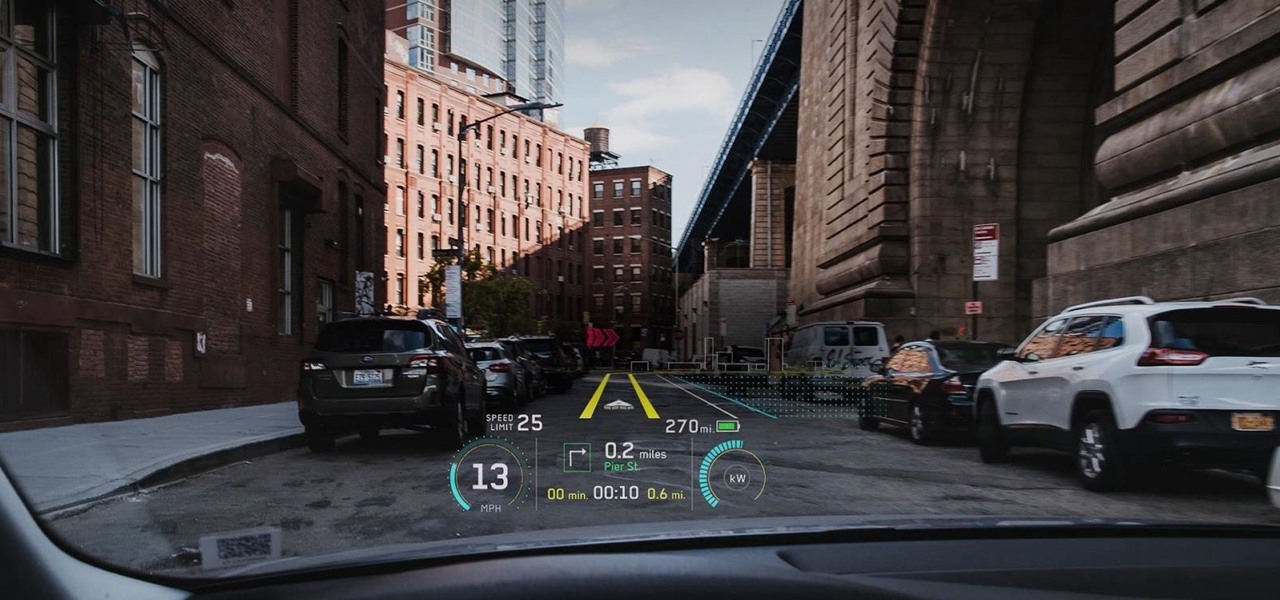While autonomous vehicles are almost assuredly the future of personal transportation, we are likely many years from seeing self-driving cars become as ubiquitous as manually-driven ones, as the auto industry has a myriad of government regulations and other constraints to contend with. Until then, augmented reality is looking like the next big thing in automotive technology.
In fact, AR in automobiles could reach mainstream relevance with most consumers before AR headsets or smartglasses. With cars, there's no cumbersome, headworn display to act as a hurdle to adoption, as content is projected onto windshields or dashboard-mounted displays. Miniaturization of computing hardware is also not as big a concern with AR in cars when compared to the challenges of embedding the same technology in a pair of smartglasses.

In many ways, the benefits of AR in cars is not unlike that seen in current applications in the enterprise arena or the use cases envisioned for consumers, streamlining relevant information, such as speed, turn-by-turn directions, or the track information of a currently-playing song, into the user's field of view. And for cars, AR also serves as a safety feature as well as a convenience, allowing drivers to keep their eyes on the road rather than instrument panels or navigation and infotainment displays.
Future advances of the technology will also place real-time content in even closer context with the driver's surroundings. For example, navigation prompts can be overlaid on the driver's view of the actual road rather than via a map depiction on the windshield (effectively blurring the lines between reality and virtual data). Using this dynamic, employing computer vision and artificial intelligence, AR can help draw a driver's attention toward hazards as well as points of interest in real time.
And when autonomous vehicles finally do make it to market in large numbers, AR will still serve as a means to show passengers what the self-driving car sees on the road, displaying relevant information on the windshield and other windows as the trip progresses.
Augmented reality HUDs are the future of car navigation systems. Rather than distracting the driver, AR navigation actually improves safety as the warnings and traffic data are placed right on the windshield. Moreover, with the rise of self-driving cars and enhanced auto control mechanisms, AR systems will enhance entertainment and communication within the car. We believe that WayRay's AR systems will bring us one step closer to advanced connected cars.
AR in Cars Today
Several models on the road today from BMW, Volvo, Chevrolet, Mazda, Lexus, Jaguar, Mercedes-Benz, MINI, and Toyota, among others, already boast AR features. The first-generation examples of AR in cars act mostly as heads up displays (HUD), presenting data from gauges, navigation prompts, and infotainment selections. In other words, it's like Google Glass for your automobile.
In addition to car-based solutions, automakers have also begun to apply augmented reality to the world of automobiles via mobile applications. Companies including BMW and Hyundai's Genesis imprint have developed AR owner's manuals. When installed on the owner's mobile device, the apps use computer vision to identify components of the interior cabin or engine, overlaying relevant information over the car's real world components to take the mystery out of owning an automobile once and for all.
Tech Companies Making AR for Cars
Similar to the tech industry, the auto industry relies on an ecosystem of vendors to supply the various parts of a vehicle. In the realm of augmented reality technology, the same holds true, as there are a number of companies that provide hardware and software to carmakers.
When it comes to hardware, the most important component is the display. Most implementations involve mirroring digital content via LCD, LED, or DLP (Digital Light Processing) and projecting data onto the windshield or a transparent dashboard display.

While more recognized today for its head-mounted displays, DAQRI has also developed a Smart HUD for automakers, with 150,000 vehicles on the road currently using the display. According to a company spokesperson in contact with Next Reality, DAQRI spun off its automotive AR business to a separate entity called Envisics in 2017. Under the new name, the company's Smart HUD will employ software-defined light (SDL) technology, which generates the AR imagery on the system.
One of the more promising vendors making displays and software for automotive AR is WayRay. The company's technology projects AR navigation prompts that appear to lie directly on the road ahead of the car from the driver's point of view.
Other important display makers include Mishor 3D (which has gained traction with Ford), Continental, and Panasonic.
In addition to displays, automakers need software to orchestrate their AR experiences. Nvidia, better known for its graphics processors, has developed a software development kit called Drive AR, a tool automakers can use build AR interfaces. Drive AR can tap into the same supercomputers that Nvidia has built for autonomous and assisted driving features to display points of interest, alerts, gauge data, and navigation prompts.
For AR owner's manuals, Bosch has developed the Common Augmented Reality Platform (CAP), which helps automakers easily author AR content.
And since cars aren't generally considered an impulse purchase for most consumers, newer innovations like AR may not be top of mind when a buyer finally makes the decision to commit to buying a vehicle. Because of this dynamic, aftermarket AR products for cars could have a more immediate impact on the market.
There are already a number of aftermarket offerings for HUDs available on the market today. For example, Navdy gives drivers a transparent dashboard display that tethers wirelessly to the driver's smartphone, pulling information from a corresponding mobile app. Drivers interact with Navdy via voice commands and hand gestures, tracked via a camera on the display.
In terms of a more immersive AR experience, WayRay has adapted the technology it has developed for automakers to a dashboard display called Navion. While not yet available to order, Navion will act as a HUD with turn-by-turn navigation and an AR navigation display, with route information projected onto the surrounding environment. Navion also includes a built-in camera for environmental mapping and tracking the vehicle's location, as well as hand-tracking for gesture input.
Companies to Watch
Surprisingly, some of the biggest names in the tech industry are missing from the early stages of the automotive AR race. But it's unlikely that they'll sit out for long. Currently, there are at least three major companies that could quickly claim a leadership position in the space if they announced their intentions tomorrow.
Google (or rather its parent company, Alphabet) is a top candidate in this regard based on its product portfolio. First of all, the company has already started and shuttered more AR initiatives than most companies, with ARCore under development as the replacement for its Tango platform, and Google Glass finding new life as smartglasses for enterprise customers.
Secondly, the company is the dominant player in terms of navigation apps with Google Maps and Waze, so an AR version of these applications would be an easy entry point into the market. Finally, the company is already very visible in its progress towards developing self-driving cars, so the computer vision and AI from this initiative could also be applied to an AR platform for cars.
APPLE
With its ambitions for fostering AR tech clearly reflected in numerous statements and actions from its CEO, Tim Cook, Apple can also be considered a potential champion of AR in cars.
In addition to its work in AR with ARKit, the iPhone X, and rumored smartglasses, the company has also been the subject of reports that it's working on AR solutions for autonomous vehicles.
Along with a potential early lead on mobile AR via iOS, by bring AR to cars, whether via CarPlay or some other product we haven't seen yet, Apple could quickly use its market position to dominate AR on the highways of the world.
TESLA
Finally, Tesla, seen by many as the leading innovator in the auto space, could be an incubator for cutting-edge AR in automobiles. While there aren't any major hints that Tesla is working on AR for its cars, the company already has vehicles on the road with some self-driving capabilities. The technology in those vehicles could eventually be married to AR features in the future.
Moreover, whatever the company does develop could eventually become a standard among automakers, as CEO Elon Musk announced in 2014 that its patents are available to all automakers via an open source philosophy of ownership. As Musk continues live out the life of a real-life Tony Stark, AR for cars is certainly within his reach.
Regardless of whether (or, more likely, when) the current tech giants get fender-deep in the game, the automotive AR industry will continue to drive forward.
"We know that augmented reality is going to define the future of user interfaces," said Nvidia CEO Jensen Huang during his company's presentation at CES 2018. "If you had a car that you ship in five years time...you will simply not understand if it doesn't have augmented reality capability."
Just updated your iPhone? You'll find new features for Podcasts, News, Books, and TV, as well as important security improvements and fresh wallpapers. Find out what's new and changed on your iPhone with the iOS 17.5 update.























Be the First to Comment
Share Your Thoughts